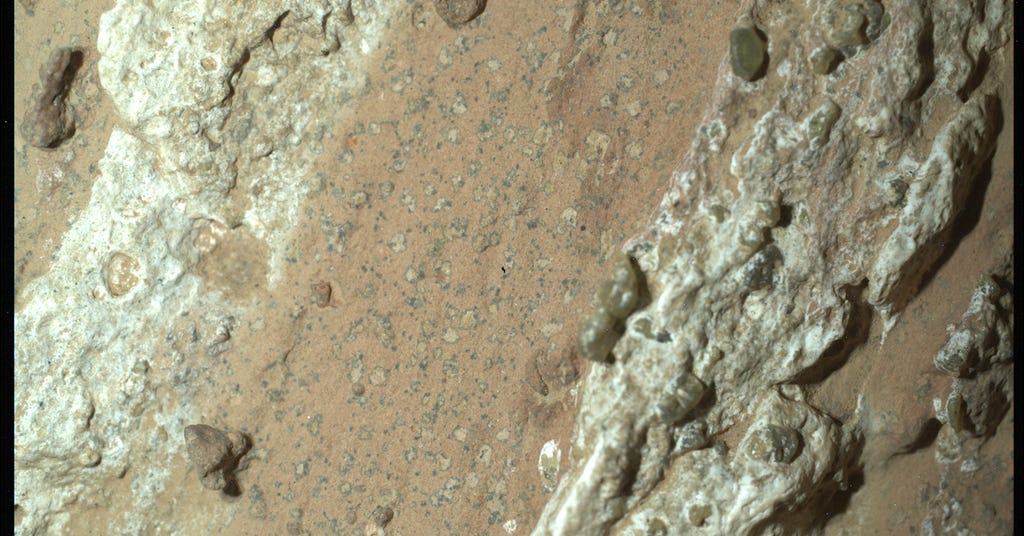The Week in Space and Physics: Was There Life on Mars?
On a discovery on Mars, the folly of a new Moon race, Trappist 1e, and the approach of an interstellar comet

The surface of Mars is old. Unlike Earth, where rain, flowing water, and the corrosive actions of life have forced constant change, Mars has barely altered in the past three billion years. But this was not always the case. Once, long ago, Mars was shaped by the force of water.
This has resulted in something quite sad. We can see where the rivers once flowed on Mars, study the lakes they must have poured into, and even spot where waves crashed across its ancient seas. But all of this has gone – at some point, for reasons still poorly understood, Mars dried out. Though we can see the shadow of where water once ran on Mars, there is nothing flowing today.
Perhaps the same holds true for Martian life. Back when Mars was partially blue, the planet should have looked rather like the young Earth. It was subject to the same processes, and for a time at least, should have been hospitable enough for living creatures to thrive. Indeed, if life could emerge on Earth, why shouldn’t it have done so on our neighbour?
Yet solid evidence has always been lacking. Experiments have found no clear sign of anything living on Mars now, and the planet certainly doesn’t have any widespread biosphere like Earth. Neither have we stumbled upon any fossils in its long dry soil, nor found signs of the action of life upon Martian rocks.
But a year ago, we did find something. In June 2024, as the Perseverance Rover studied rocks lying in an old riverbed, it found an odd pattern of spots etched upon one of them. Closer examination found organic compounds, and deduced that the spots were probably made of two iron- and phosphate-rich minerals: greigite and vivianite.
On our planet, these minerals are laid down by simple organisms, and if we had found these same spots on a rock on Earth, we would have concluded that life was to blame. Yet this is a rock on Mars – and if the spots were made by life, then this is an astonishing discovery. It would be, indeed, the first clear evidence of life on a world beyond our own.
Over the past year, scientists have thus taken a closer look at these spots. There are possible ways they could have been made without life, they say. But all require high temperatures that would be unlikely in a place like this. The most reasonable explanation, they therefore conclude, is that these spots really are biological in origin.
Yet given the enormity of this discovery, they are being cautious. Mars has been dry for billions of years now, and, given all that time there is still a possibility the spots formed in some unexpected way. This is thus a “potential biosignature”, they say, a feature that is consistent with the past presence of life. But to make a definite conclusion – aliens or no aliens - we will need more evidence.
That can only come in two ways. One is to bring a sample of these rocks back to Earth. Perseverance has drilled one out and left it on the surface of Mars for future collection. But NASA, right now, has no clear plans for how to retrieve it. The other is to visit Mars in person, and study the rocks in their natural environment.
A New Race to the Moon?
According to Sean Duffy, newly appointed as acting administrator of NASA, the United States is in a race back to the Moon. One could easily question the wisdom of declaring such a race. At the very least, America seems to have little to prove: it has been to the Moon before, and despite that, chose not to go back again for half a century. Even worse, it looks like the main competitor - China - might well win any new space race.
In any case, to get back to the Moon, a minimum of three things are needed: a big rocket, a capsule, and a lander to take astronauts to the surface. America already has the first two of these – the SLS rocket, expensive as it is, lofted the Orion capsule into a lunar trajectory back in 2022. Both the SLS and Orion should fly again early next year, on a mission that will take American astronauts around the Moon for the first time since 1972.
But America still lacks a viable lander. Current plans call for SpaceX’s Starship to fulfil this role, but the giant spacecraft is clearly oversized for the task, and SpaceX is anyway struggling to get it ready in time. When they’ll be done is anyone’s guess, but it looks increasingly unlikely Starship will reach the Moon before the late 2020s.
China, by contrast, seems to be moving steadily ahead. In the past few years they’ve pulled off a series of challenging robotic missions to the lunar surface, and now have their sights on a crewed landing by 2030.
Unlike America, they have not yet flown a Moon rocket. But they are getting closer. In August, they conducted test fires of the Long March 10, a giant new rocket capable of carrying astronauts into deep space. Alongside this, they’ve been testing Mengzhou, the capsule that will support their lunar efforts, and Lanyue, the lander that will carry astronauts to and from the surface.
Reports suggest China will attempt a first launch of Long March 10 in 2027. The steps after that are unclear – but it seems reasonable to think China will send astronauts to loop around the Moon before then attempting a landing. That, after all, was how America did it more than half a century ago.
An Atmosphere Around TRAPPIST-1e
The Trappist system is one of the best-studied star systems beyond our own. It lies about forty light years from Earth and consists of seven small rocky planets in orbit around a faint red star. Three of these planets lie at the right distance to be warm and Earth-like, and they could, in theory at least, be ocean worlds with thick, comfortable atmospheres.
With the James Webb telescope, we have the ability to examine these planets. Its early results have been slightly disappointing: the three inner worlds of the Trappist system, it found, are probably airless rocks akin to Mars or Mercury. There is certainly no water or life on any of them.
But the fourth world out, Trappist 1e, looks more promising. In a pair of papers published last week, astronomers said they’d found signs of a nitrogen-rich atmosphere around it. That might look something like the thick atmosphere around Titan, they say, or, plausibly, it could be something like our own atmosphere here on Earth.
They caution, however, that the data is not yet strong enough to be certain of what we are seeing. Indeed, follow-up work might find the observations to have been illusory, and that in fact the planet has no atmosphere at all. Or, they might find evidence in the other direction, and thus show the planet could actually be habitable.
The James Webb is already gathering the data needed to find out, and should complete this task by the end of the year. Sometime in the next few months, then, we should finally find out if the Trappist system has the potential for life or not.
3I/Atlas
The interstellar comet 3I/ATLAS is falling rapidly towards the inner Solar System. Within the next few weeks it will fly past Mars, disappear from view behind the Sun, and then, having reached its perihelion, emerge once again in December. After that it will be flying away from us, heading back out towards interstellar space.
This gives us a brief window in which to study the comet. Although it is unlikely we’ll be able to send any spacecraft to directly examine it, telescopes have been hard at work watching it from a distance. Two of them – SPHEREx and the James Webb Space Telescope – recently looked at the gases streaming out from its surface.
Both found surprisingly high levels of carbon dioxide. This, a report in Sky and Telescope points out, contrasts sharply with the usual comets found in our solar system, most of which contain more water than carbon dioxide. The difference, researchers say, might be down to where the comet formed, although to draw stronger conclusions we’ll need to keep studying the comet as it draws closer to us.
Read More
The Mysterious Origins of the Third Interstellar Comet
Three weeks ago, a robotic telescope in Chile spotted a comet moving …
What Dark Energy Means For The End of Time
Long ago, long before humankind had dreamed of science, of forces and atoms, of dark matters and dark energies filling the void, our deep ancestors looked up at the splendor of the night and wondered. How, some child must have asked, did it all begin? And then, after some thought: how will it all end?
What Lies Beyond: Exploring Interstellar Space
The scale of things is hard to grasp. The distance from Earth to the Moon - some four hundred thousand kilometers - is the shortest cosmic scale of any significance, but one that already stretches th…






In other news, Earthlings are being treated to the best view of Saturn we'll get for a while. Saturn's rings are even visible through standard binoculars! V. happy to share one of our astronomer's thoughts on star gazing offering food for the soul.
https://unswscience.substack.com/p/you-can-see-saturn-outside-your-bedroom
I'd rather have a Mars race than a moon race, but are they connected? Is the idea to use a moon base as staging area for Mars?